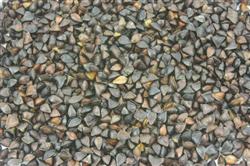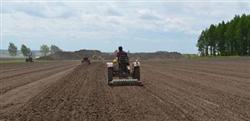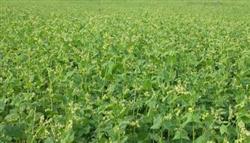Sowing buckwheat depends on the season.

Buckwheat emerges with leaves, which is difficult to emerge, and sowing should not be too deep. The sowing depth directly affects the neatness of seedling emergence, which is the key to the whole seedling. To master the sowing depth, first, it depends on the soil moisture, the moisture is sufficient and shallow, and the lack of moisture is deep; second, it depends on the sowing season, spring buckwheat should be deep, summer buckwheat is slightly shallow; third, it depends on the soil quality. sandy soil and dry land can be deeper, but not more than 6 centimeters. Field management is an important link for buckwheat to obtain high yield. There are many tasks in field management. in view of the key technologies in buckwheat production, scientific management measures are adopted to ensure yield increase and stable yield. To ensure that when the whole seedling is sown in case of drought, it is necessary to timely suppress, break the large soil field, stabilize the soil, reduce the gap, make the soil solid on the soil tillage layer, and connect the seeds closely, so as to facilitate the emergence of seeds with rising moisture. Buckwheat cotyledons are large, the ability of the top soil is poor, and the ground hardening affects the emergence of seedlings. The agricultural proverb says, "buckwheat not dry soup (hardening), take cloth bags." As long as it is not rigid, it will be easy for the whole seedling. Therefore, we should pay attention to breaking the surface hardening, shallow rake when the ground is slightly dry after the rain, so as not to damage the seedlings. Buckwheat prefers dampness to water, and too much water is disadvantageous to the growth of buckwheat, especially at the seedling stage. Field drainage should be done well before and after sowing buckwheat in lowland and steep land. Intertillage weeding is carried out after the first leaf, and then depends on the area, soil, seedling condition and the number of weeds. 3 times of spring buckwheat, 2 times of summer buckwheat, and 2 times of summer buckwheat, and the depth of intertillage was 3. 5 cm. While weeding, vegetable seedlings and inter-seedlings were carried out at the same time to remove weak seedlings, reduce seedling crowding, improve the uniformity and fruiting rate of buckwheat plants, and cultivate soil. Generally, before budding and flowering, the soil is cultivated when the plant height is 20ml / 25cm, which promotes root growth, reduces lodging, and improves root absorptive capacity and drought resistance. Irrigated buckwheat is a crop with weak drought resistance and more water demand. In the whole growth period, flowering filling needs the most water. Spring buckwheat is mostly planted in dry land and sloping land, with little rain or uneven drought and waterlogging all the year round, lack of irrigation conditions, and growth depends on natural rainfall, which has a great impact on buckwheat yield. Where there are conditions for irrigation, attention should be paid to light irrigation, and it is better to use depression irrigation and furrow irrigation. Auxiliary pollination of buckwheat is a flowering and pollination crop with two types of flowers, and the seed setting rate is low. Tartary buckwheat was lower than that of Tartary buckwheat under the same conditions. The better way to improve the seed setting rate of buckwheat is auxiliary pollination. There are two kinds of auxiliary pollination: bee-assisted pollination and artificial pollination. 1. Bee-assisted pollination: buckwheat is an insect-borne flower crop. Honey bees and insects can improve the fruiting year of sweet buckwheat pollination. Beekeeping and beekeeping in the field is not only one of the measures to increase buckwheat yield, but also conducive to the development of beekeeping. two。 Artificial pollination: in places where there are no conditions for putting bees, artificial pollination is used. The main method is to gently pull the buckwheat along the top of the buckwheat and shake the plant with a piece of cloth with a length of 300cm long and a width of 30cm tied with a rope at each end of the cloth every two or three days during the full flowering period.
- Prev

Key points of planting techniques of buckwheat
The growth period of buckwheat is short, and it can mature in 80 days. The key points of high-yield cultivation techniques of buckwheat are as follows: 1. Fine ground preparation. The unearthing ability of buckwheat seedlings is weak, so we should pay attention to fine soil preparation and create an environment conducive to the growth and development of buckwheat seedlings. two。 High quality sowing. Before and after buckwheat the Beginning of Autumn.
- Next

Cultivation techniques of Fagopyrum esculentum
Golden buckwheat is the dry rhizome of buckwheat in Polygonaceae, also known as Tartary buckwheat, Yeqiao buckwheat, buckwheat. It has the functions of clearing heat and detoxification, promoting blood circulation and removing blood stasis, invigorating the spleen and promoting dampness. Mainly produced in Shaanxi, Jiangsu, Zhejiang, Hubei, Hunan and other provinces, East China can also be cultivated. A morphological feature.
Related
- The first cup of black tea in spring, the flavor and history of tea gardens in Kenya, Africa
- The computer can not only choose potatoes, but also grow tea rice. AI will grow winter oolong tea champion.
- It is not only the inflated tea bitten by insects, but also engraved with the four seasons tea in Beipu.
- The Oriental Beauty Tea Festival in Zhuxian County takes the stage at the weekend to experience the plus-size feast of oil tea.
- & quot; Oriental Beauty Tea & Exploration of Emei in Hsinchu, the hometown of quot;
- The new variety of strawberry "Tainong 1" dessert is the first choice with mellow aroma. Crimson gorgeous
- History of Tea in Taiwan: from Wild Inner Mountain to Export Tea Garden
- Two types of Taiwan Oriental Beauty Black Tea won the British three-Star Award for Childhood Tea Xiang Zhang Jiaqi changed from pilot to champion tea maker.
- Banana species and varieties: the planting history of Taiwan Xianren banana and dwarf banana is long, is banana disease resistant?
- Coffee planting Technology: Qianjie Coffee from Seedling to harvesting

